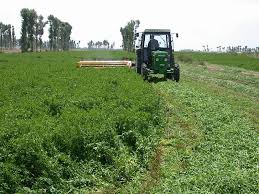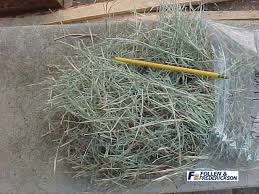
In this time of drought and short hay supplies, horse owners should be careful when shopping for hay. I have had to turn 18 wheeler loads of hay around because the quality was not what was promised.Y
ou must ask questions. Check the entire lot of hay you are purchasing before unloading. If you are not familiar with the hay dealer, ask for references. After all, being a knowledgeable hay buyer is part of being a responsible horse owner.
Many different types of hay are suited for horse feeding programs. The popularity of a particular type is usually influenced by the geographical area. Here in South Texas, coastal bermudgrass is well adapted and thus quite popular. As you move north, alfalfa, timothy, orchardgrass and alfalfa/grass mixes become more popular. Because of the potential for health problems, kleingrass, Johnsongrass, Sudangrass and sorghum/Sudan hybrids are not recommended for horses.
When choosing a type of hay to feed to horses consider several factors. Most important is cleanliness, followed by nutrient value, and the type of horse being fed.
 The best hay for horses is clean hay. If hay is moldy or dusty, it should not be fed to horses. Hay that contains dust or mold can inflame their respiratory tracts and impair breathing ability. Hay with mold or dust suggests that conditions in the field when hay was cut and baled were not ideal.
Is the hay insect free? Alfalfa hay may be infected with blister beetles. When a horse eats a blister beetle, a chemical called Cantharidin in the beetle causes colic, fever, and eventually death. Color is often used to determine hay quality, yet it can deceiving and overestimated as an indicator of quality. Although bright green hay often indicates the absence of rain damage and good harvest conditions, color can be misleading. I have fed lightly rained on bermudagrass hay that was not the best looking hay but was still high quality forage. Bright green weeds can add color yet lower quality of hay and make it unpalatable.
The best hay for horses is clean hay. If hay is moldy or dusty, it should not be fed to horses. Hay that contains dust or mold can inflame their respiratory tracts and impair breathing ability. Hay with mold or dust suggests that conditions in the field when hay was cut and baled were not ideal.
Is the hay insect free? Alfalfa hay may be infected with blister beetles. When a horse eats a blister beetle, a chemical called Cantharidin in the beetle causes colic, fever, and eventually death. Color is often used to determine hay quality, yet it can deceiving and overestimated as an indicator of quality. Although bright green hay often indicates the absence of rain damage and good harvest conditions, color can be misleading. I have fed lightly rained on bermudagrass hay that was not the best looking hay but was still high quality forage. Bright green weeds can add color yet lower quality of hay and make it unpalatable.
 The biggest factor that affects nutrient content within a type of hay is the stage of maturity at harvest. Hay that is cut very early in the forage growth stage often has a soft texture, is very leafy, and has a high nutrient density and palatability. Forages harvested at this stage are cut soon after the seedheads emerge (with grasses) or before the plant begins to bloom (with legumes). Often alfalfa is cut at approximately 25-30% bloom and blooms will be present in the hay- this is still considered high quality alfalfa. In contrast, forages harvested in late maturity will have coarse, thick stems and less leaf material. Bottom line, the more mature the plant at harvest, the lower the nutrient value and palatability.
The best way to evaluate the nutrient value of a hay sample is to have a chemical analysis performed form a lab like the Forage Testing Lab at Texas A&M University. A submittal form and sampling instructions can be found at this web site: http://soiltesting.tamu.edu/files/Forageweb2.pdf
The biggest factor that affects nutrient content within a type of hay is the stage of maturity at harvest. Hay that is cut very early in the forage growth stage often has a soft texture, is very leafy, and has a high nutrient density and palatability. Forages harvested at this stage are cut soon after the seedheads emerge (with grasses) or before the plant begins to bloom (with legumes). Often alfalfa is cut at approximately 25-30% bloom and blooms will be present in the hay- this is still considered high quality alfalfa. In contrast, forages harvested in late maturity will have coarse, thick stems and less leaf material. Bottom line, the more mature the plant at harvest, the lower the nutrient value and palatability.
The best way to evaluate the nutrient value of a hay sample is to have a chemical analysis performed form a lab like the Forage Testing Lab at Texas A&M University. A submittal form and sampling instructions can be found at this web site: http://soiltesting.tamu.edu/files/Forageweb2.pdf
 Another option for a hay source would be hay cubes. There are two possible advantages to feeding hay cubes over baled hay: less dust than long hay and less waste. Hay cubes are usually more expensive than baled hay and consumption of cubes may be greater than with baled hay.
To get the most value from hay it would be best to have some type of hay feeder, which reduces the amount of hay that the horses waste and in many cases can reduce waste by more than 20 percent.
More information about hay sources may be found at the Texas Department of Agriculture web site “Hay Hotline” http://www.gotexan.org/HayhotlineHome.aspx
Another option for a hay source would be hay cubes. There are two possible advantages to feeding hay cubes over baled hay: less dust than long hay and less waste. Hay cubes are usually more expensive than baled hay and consumption of cubes may be greater than with baled hay.
To get the most value from hay it would be best to have some type of hay feeder, which reduces the amount of hay that the horses waste and in many cases can reduce waste by more than 20 percent.
More information about hay sources may be found at the Texas Department of Agriculture web site “Hay Hotline” http://www.gotexan.org/HayhotlineHome.aspx
No comments:
Post a Comment